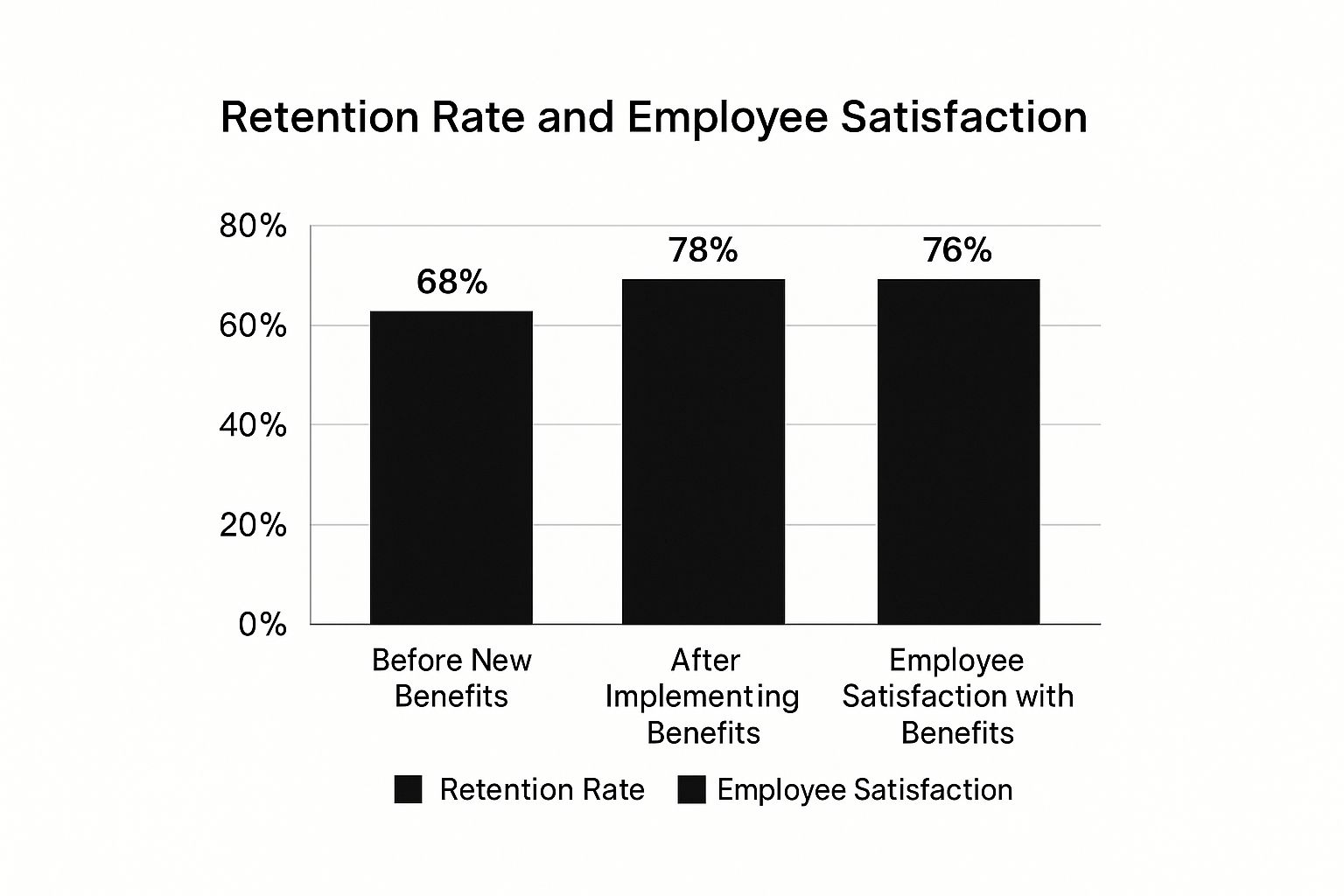The Hidden Costs of Employee Turnover
Losing employees costs a company much more than just the price of finding, hiring, and training replacements. The obvious costs are easy to see, but the hidden costs of employee turnover often go unnoticed, significantly impacting a company's bottom line. This section explores those less obvious, yet equally harmful, expenses that affect everything from teamwork to client relationships.
The Impact on Team Dynamics and Productivity
When a valued team member leaves, the remaining employees experience a disruption that goes beyond their daily work. Team cohesion and trust weaken, leading to lower productivity and higher stress. Existing employees often take on extra work, which can lead to burnout and possibly even more resignations. Imagine a well-oiled machine missing a crucial part. It might still run, but less efficiently and with greater strain on the remaining parts.
The Disruption of Customer Relationships
Strong customer relationships are built on trust and familiarity. When employees leave, these relationships are often disrupted. Clients might hesitate to work with new people, requiring extra time and effort to rebuild that connection. This can lead to lower customer satisfaction, lost business, and ultimately, reduced revenue. A departing employee might also take valuable client knowledge and insights with them, giving their new employer a competitive edge.
The Competitive Disadvantage
High employee turnover puts a company at a disadvantage. The financial cost is substantial, highlighting the importance of effective employee retention strategies. Losing an employee typically costs about one-third of their annual salary. Businesses with high turnover are often less profitable than those with strong retention and engagement, showing a 23% profitability gap. The Great Resignation, for example, saw a huge jump in resignations, with 50.5 million employees quitting in 2022. This emphasizes the need for businesses to prioritize keeping their employees as a key part of their overall strategy for staying profitable and competitive. Learn more about employee retention here. This loss of knowledge, combined with the time it takes to onboard new hires, allows competitors to catch up. They can take advantage of the instability and attract both clients and potential employees looking for a more stable and promising work environment. Prioritizing employee retention isn't just an HR issue; it's a crucial strategic move for any organization aiming for long-term success.
Career Development That Actually Keeps People Engaged

Today's employees crave more than just a salary; they seek meaningful work and opportunities to grow. This means organizations must evolve beyond standard training and embrace career development that truly resonates with individual ambitions while aligning with company goals. This focus is key to retaining valuable team members.
Personalized Growth Paths: A Roadmap for Success
Imagine a personalized roadmap guiding each employee toward their professional aspirations. Instead of generic training programs, organizations are now crafting customized growth paths. These paths empower employees to envision their future with the company, fostering commitment and reducing the desire to seek opportunities elsewhere. It's about empowering individuals to take ownership of their development and see a clear path forward.
Mentorship Programs: Fostering Connection and Growth
Mentorship programs are essential for personalized career development. They connect employees with seasoned mentors who provide guidance, support, and invaluable insights. This cultivates a sense of belonging and makes employees feel valued and invested in. Mentorship also facilitates knowledge sharing and skill development, benefiting both mentor and mentee. For example, a junior marketing associate might be paired with a senior marketing manager to learn the intricacies of strategy and campaign execution.
Skill-Building Initiatives: Delivering Immediate Value
Beyond mentorship, organizations are investing in skill-building initiatives that provide immediate value. These initiatives can include workshops, online courses, on-the-job training, and cross-departmental projects. By focusing on skills relevant to current roles and future goals, these initiatives boost employee engagement and contributions to the organization. This investment shows a commitment to growth, strengthening employee loyalty and motivation. Investing in career development is a powerful retention strategy. In fact, 93% of employees are more likely to stay with an organization that invests in their career development. Learn more about these statistics here. This underscores the importance of providing continuous learning and opportunities for advancement.
Practical Frameworks for Sustainable Growth
Even organizations with limited resources can create impactful career development programs. By emphasizing clear communication, providing internal mobility opportunities, and establishing regular feedback mechanisms, companies can nurture a culture of growth. This not only benefits employees but also ensures the organization has a skilled and adaptable workforce prepared for future challenges. Investing in career development is a win-win, fostering both employee retention and organizational success.
Building a Culture People Actually Want to Be Part Of
Beyond ping pong tables and casual Fridays, what truly makes employees stick around? It's about cultivating a company culture that inspires genuine loyalty and a sense of belonging. This goes beyond surface-level perks; it's about fostering an environment where employees feel truly valued, respected, and empowered to contribute their best.
Psychological Safety: The Foundation of a Thriving Culture
One of the cornerstones of a positive culture is psychological safety. This means establishing an environment where employees feel comfortable taking risks, sharing their ideas, and even admitting mistakes without the fear of judgment or negative repercussions. When employees feel safe to speak their minds, innovation thrives, and teams collaborate more effectively. Imagine a junior team member hesitant to share a potentially revolutionary idea for fear of ridicule. A culture of psychological safety empowers them to speak up, possibly leading to a major breakthrough and strengthening their sense of belonging.
Authentic Recognition: More Than Just a Pat on the Back
While recognition programs are common, they often miss the mark when they lack sincerity. Authentic recognition isn't about generic praise; it's about acknowledging individual contributions in a meaningful and personal way. This could be highlighting specific achievements in team meetings, writing personalized thank-you notes, or providing professional development opportunities based on demonstrated skills. Publicly acknowledging contributions can amplify the positive impact.
Leadership by Example: Modeling the Values You Preach
Effective leaders don't just talk the talk; they walk the walk. When leaders consistently embody the behaviors they expect from their teams, it sets a powerful example and creates a ripple effect throughout the organization. This reinforces the desired culture and builds trust between leadership and employees. This consistent demonstration of values is what truly embeds a strong culture within a company.
Building Belonging and Addressing Toxicity
Creating a sense of belonging is especially important in today's diverse workplaces. This means fostering an inclusive atmosphere where each individual feels valued and respected for their unique perspective and contributions. At the same time, organizations must proactively address toxic behaviors before they escalate. This includes taking swift action against harassment, discrimination, and bullying. This protects employees and contributes to a healthier, more positive work environment. This proactive approach not only cultivates a more positive work environment, but also significantly improves employee retention. The data chart below visually represents the key factors impacting employee retention, as identified in recent surveys. This bar chart highlights the relative importance of factors such as compensation, benefits, work-life balance, career development opportunities, and company culture.

The chart clearly shows that while compensation is a factor, elements like career development and a positive company culture are equally, if not more, impactful in an employee's decision to stay. This emphasizes a holistic approach to retention, focusing not just on monetary rewards but also on fostering a supportive and fulfilling work environment.
Fostering a healthy culture isn't just about launching initiatives; it's also about actively measuring their impact. Practical measurement approaches include pulse surveys and regular feedback mechanisms. These tools provide valuable insights into employee sentiment and can even help predict turnover. The recent decline in the Employee Retention Index, as reported by Eagle Hill Consulting, underscores the challenges businesses face. The index fell by 6.2 points in the first quarter of 2025, the steepest drop in two years. Key contributors include declines in organizational confidence (4.5 points), culture ratings (3.1 points), and compensation satisfaction (7.9 points). Addressing these concerns is vital for improving retention. You can explore more detailed statistics here.
To further illustrate the key factors affecting employee retention, we've compiled the following table:
Key Factors Influencing Employee Retention
This table presents the primary factors affecting employee retention, their impact level, and implementation difficulty.
| Factor | Impact on Retention | Implementation Difficulty | ROI Potential |
|---|---|---|---|
| Competitive Compensation | High | Medium | High |
| Comprehensive Benefits | Medium | Medium | Medium |
| Positive Work-Life Balance | High | Medium | High |
| Career Development Opportunities | High | Medium to High | High |
| Strong Company Culture | High | High | High |
| Effective Leadership | High | High | High |
| Recognition and Rewards | Medium | Low to Medium | Medium to High |
This table reveals that while factors like compensation and benefits are important and relatively straightforward to implement, other factors such as company culture and effective leadership, while having a high impact, are more challenging to cultivate, but offer substantial long-term ROI. Focusing on these more difficult but impactful areas can lead to significant improvements in overall employee retention.
Compensation Strategies That Actually Work

Compensation and benefits are essential for attracting and retaining top talent. But their true power lies in their ability to inspire and motivate. This section explores how leading organizations are strategically crafting total rewards programs to cultivate a thriving workforce. It’s not simply about offering the biggest paycheck, but about creating a holistic system that recognizes, values, and invests in employees.
Transparency in Pay Practices: Building Trust and Equity
A cornerstone of successful compensation strategies is pay transparency. Openly communicating salary ranges and the rationale behind compensation decisions cultivates trust and a strong sense of fairness. This transparency eliminates ambiguity and empowers employees to understand how their unique contributions are valued within the organization.
For example, by clearly outlining performance metrics and skill levels associated with various pay grades, companies can empower employees to chart their own growth trajectory. This clarity instills a sense of equity and reduces the likelihood of employees seeking greener pastures elsewhere. When people feel valued and understood, they are more likely to stay engaged and committed.
Equity Programs: Creating Long-Term Commitment
Beyond base salary, forward-thinking organizations are leveraging equity programs as a powerful retention tool. Offering stock options or profit-sharing plans gives employees a tangible stake in the company's success, aligning their personal aspirations with the organization's overarching goals. This shared sense of ownership is especially impactful in startups and high-growth environments.
This ownership mentality fosters deeper commitment and encourages employees to actively contribute to the overall prosperity of the company. They become invested in the long-term vision, driving innovation and propelling the organization forward.
Emerging Benefits: Addressing Employee Needs
Modern organizations recognize the importance of offering benefits that resonate with the evolving needs of their workforce. This transcends traditional health insurance and retirement plans. Emerging benefits, like flexible work arrangements, generous parental leave, mental health resources, and student loan repayment assistance, are proving invaluable in attracting and retaining talent.
These benefits demonstrate a commitment to employee well-being and a healthy work-life integration. These factors are key drivers of retention, creating a supportive environment where individuals can flourish both personally and professionally.
Conducting Effective Compensation Reviews
Regular and thoughtfully structured compensation reviews are essential for maintaining internal equity and ensuring competitiveness within the external market. These reviews should consider both internal factors, such as job performance and skill development, and external factors, such as market salary data for comparable roles. This data-driven approach ensures compensation remains fair, competitive, and aligned with industry standards.
However, even organizations operating within budget constraints can implement impactful retention strategies. Prioritizing career development, cultivating a positive and supportive work environment, and offering flexible work arrangements can be highly effective in keeping employees engaged and fulfilled, even without relying solely on financial incentives.
Budget-Friendly Retention Strategies: Maximizing Value
Many organizations grapple with employee turnover due to limited resources. However, a focus on career development, fostering a strong company culture, and providing flexible work arrangements can significantly enhance employee retention. These non-monetary incentives can be just as impactful as financial rewards, especially for employees who value work-life balance and opportunities for professional growth.
Offering clear paths for advancement and acknowledging employee contributions are cost-effective ways to demonstrate appreciation and boost morale. These seemingly small gestures can make a significant difference in creating a culture of recognition and belonging, ultimately contributing to higher retention rates and a more engaged and dedicated workforce. By embracing these strategies, organizations can create a compelling value proposition that motivates employees to invest in their careers and commit to the shared success of the company.
Transforming Onboarding Into a Retention Superpower
The first few months in a new role are pivotal for an employee. They significantly impact the decision to stay or leave. A well-structured onboarding experience can be incredibly effective for boosting long-term retention. This goes beyond simple paperwork and introductions. It's about fostering a sense of belonging and setting the stage for ongoing growth and development.
Beyond the Basics: Onboarding for Engagement
Effective onboarding transcends administrative tasks. It's about crafting a truly engaging experience right from the start. This means equipping new hires with the resources they need to thrive. It also means nurturing meaningful connections and providing a clear understanding of their role in the larger company mission.
For instance, assigning mentors to new employees can accelerate their integration into the team. Mentorship allows new hires to learn from seasoned colleagues and quickly adapt to the company culture.
The Role of Technology in Personalized Onboarding
Technology empowers us to personalize onboarding while maintaining consistency. Automated systems can track new hire progress, deliver targeted training materials, and even facilitate introductions between team members.
The human touch remains essential, though. Regular check-ins with managers and HR representatives create a supportive environment. This allows new hires to ask questions, voice concerns, and feel valued. This powerful combination of automation and human interaction builds a strong foundation for engagement.
Feedback: The Key to Predicting Retention Challenges
Systematic feedback during the initial onboarding period provides invaluable insights. These insights can illuminate potential retention challenges before they escalate. Regular pulse surveys and one-on-one conversations allow new hires to openly share their experiences. This early feedback loop identifies areas for improvement and allows you to address concerns promptly. It also enables you to refine the onboarding process to better suit employee needs. Addressing concerns quickly dramatically enhances the onboarding experience.
Let's explore how various industries approach employee retention:
To illustrate this, let's examine some industry-specific data:
Employee Retention Statistics by Industry
This table presents retention rates, turnover costs, and primary retention drivers across different industries.
| Industry | Average Retention Rate | Average Turnover Cost | Top Retention Drivers |
|---|---|---|---|
| Technology | 80% | $60,000 | Career development, competitive salary, work-life balance |
| Healthcare | 75% | $50,000 | Benefits, work-life balance, positive work environment |
| Finance | 85% | $70,000 | Competitive salary, bonuses, career advancement opportunities |
| Retail | 60% | $20,000 | Competitive pay, flexible schedules, employee discounts |
| Manufacturing | 70% | $30,000 | Job security, benefits, training opportunities |
As shown in the table, retention drivers vary across industries. While competitive salaries are important across the board, other factors like work-life balance, benefits, and career development play significant roles.
Creating a Lasting Impact
Focusing on building connections, providing clarity, and fostering a sense of belonging transforms onboarding into a true retention superpower. This sets the stage for long-term commitment and helps new hires transition into valued team members. This sustained engagement naturally leads to higher retention rates and a more productive, thriving workforce. These positive effects extend far beyond the initial onboarding phase, shaping the entire employee lifecycle.
Turning Managers Into Retention Champions

While compensation and benefits play a vital role, research increasingly reveals that employees often choose to leave their managers, not the companies themselves. This underscores the crucial link between effective management and employee retention. This section explores how to empower managers to become true champions of retention.
Identifying Management Behaviors That Predict Retention
Certain management behaviors are strong indicators of team stability. Managers who prioritize open communication create a transparent and collaborative environment where team members feel heard and valued. Regular feedback, both positive and constructive, helps employees understand their strengths and areas for growth. Actively supporting career development demonstrates a commitment to each individual's long-term success.
These positive behaviors cultivate trust and strengthen the essential manager-employee relationship. Recognizing and appreciating employee contributions fosters a sense of belonging and motivates individuals to remain with the organization.
Recognizing Flight Risks Through Conversation Patterns
Managers can often detect potential flight risks by being attuned to subtle shifts in conversation patterns. A sudden disengagement in team meetings, decreased contribution to projects, or a noticeable increase in negativity could all be warning signs.
For example, an employee who once actively participated in brainstorming sessions might become withdrawn. This change in behavior may indicate dissatisfaction and a potential desire to leave. By recognizing these patterns, managers can proactively address underlying issues and prevent potential departures.
Coaching Approaches for Building Loyalty
Practical coaching approaches can significantly enhance employee retention. Managers who provide individualized support demonstrate a genuine interest in their team members' well-being and professional growth. Helping employees navigate challenges, both personal and professional, builds resilience and strengthens their commitment to the team.
Celebrating successes, both big and small, creates a positive and encouraging work environment. This individualized attention reinforces employees' sense of value and fosters loyalty within the organization. Addressing concerns promptly and providing opportunities for growth further solidifies this commitment.
Frameworks for Retention-Specific Management Training
Traditional management training programs often focus on broad leadership principles. However, retention-specific training equips managers with the targeted skills they need to retain their most valuable employees. These skills include navigating difficult conversations, delivering constructive feedback effectively, and creating meaningful development opportunities.
This focused training empowers managers to address the specific challenges that can contribute to employee turnover. By providing them with the necessary tools and strategies, organizations can significantly improve their retention rates. This targeted approach leads to measurable results and contributes to a more stable and engaged workforce.
Accountability and Intervention Strategies
Accountability systems are vital for ensuring that retention remains a top priority. Organizations should reward managers who demonstrate excellence in retaining their teams and implement intervention strategies for those whose management styles contribute to unwanted turnover.
This might involve mentorship programs, additional training focused on specific areas for improvement, or performance improvement plans. Addressing these issues directly creates a culture of retention and contributes to the organization's long-term success. This proactive approach reinforces accountability and ensures that managers are actively working towards shared retention goals.
Measuring What Actually Matters for Retention
Stopping employee turnover begins with understanding the why behind an employee's decision to leave. This requires going beyond simply monitoring your overall turnover rate. Data-driven organizations delve deeper, using analytics to understand the underlying factors influencing retention and predict future attrition.
Metrics Beyond Turnover Rate: Predicting Future Stability
While the turnover rate provides a general overview, more specific metrics offer a much clearer picture. For example, examining turnover within individual departments, demographics, or tenure groups can reveal hidden trends. Perhaps your engineering department has a substantially higher turnover rate than other teams. Or maybe employees with less than two years of tenure are leaving more rapidly. These insights can pinpoint your real retention challenges. This targeted approach enables focused interventions for maximum impact, rather than relying on broad, generic solutions.
The Power of Stay Interviews: Uncovering Actionable Insights
Stay interviews, conducted with current employees, offer powerful insights into why people choose to remain with your organization. These conversations are distinct from performance reviews. They are opportunities to explore what motivates employees, what challenges they face, and what factors might lead them to consider leaving in the future. Asking open-ended questions about their career goals, their work-life balance, and their overall job satisfaction can reveal valuable information. For instance, a stay interview might uncover that an employee is considering leaving due to perceived stagnation in their career development. This provides a crucial opportunity to proactively address the issue before it escalates into a resignation.
Setting Meaningful Retention Goals: A Data-Driven Approach
After identifying your key retention challenges and gathering insights from stay interviews, you can set meaningful retention goals. Instead of simply aiming for a lower overall turnover rate, establish SMART goals – Specific, Measurable, Achievable, Relevant, and Time-bound. You might aim to reduce turnover in the engineering department by 10% within the next year, or increase the average tenure of employees in entry-level roles by six months. These focused objectives guide your retention strategies and allow you to track progress effectively, leading to a more targeted and successful approach.
Predictive Analytics: Flagging Flight Risks Before They Leave
Implementing predictive analytics elevates retention efforts. By analyzing diverse data points, such as performance reviews, employee surveys, and even email communication patterns, organizations can identify flight risks before they submit their resignations. This early warning system allows for proactive intervention, perhaps addressing concerns, providing development opportunities, or adjusting workloads. This proactive approach can drastically reduce the high cost of turnover. Imagine a valued employee consistently working late, expressing dissatisfaction in surveys, and demonstrating decreased engagement in team meetings. Predictive analytics can flag this individual as a potential flight risk, empowering their manager to intervene, offer support, and address any underlying issues.
Are you ready to transform your HR strategies and cultivate a thriving workforce? The Global Human Resource Institute offers comprehensive courses and certifications designed to equip you with the tools and knowledge you need to address modern HR challenges, including employee retention. Visit the website to learn more and empower your HR team to achieve enduring success.




0 Comments